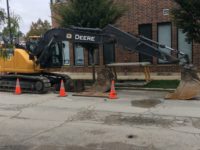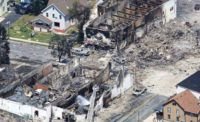The dust has settled from a methane explosion last month that brought down the roof of a sludge concentration building at the Calumet water reclamation plant on Chicago’s far south side, but there is still uncertainty as to what triggered the blast.
The roof collapse injured 10 workers, one seriously. Carl Malinowski, 51, had worked in maintenance at the 96-year-old plant for more than a decade when he was called on Aug. 30 to perform the routine procedure of removing a frozen bolt with an acetylene torch.
His bosses at the Metropolitan Water Reclamation District of Greater Chicago describe Malinowksi as a “skilled, trained ironworker.” On the day of the explosion, he was carrying a portable gas meter meant to detect high levels of dangerous gases in the air.
Hours later, 70 rescue workers had to dig and tunnel through 40 feet of concrete to save the trapped and badly injured Malinowski. An initial Chicago Fire Dept. investigation found that a methane explosion caused by a worker’s torch was the cause.
“Methane is explosive and must be handled properly,” said Allison Fore, public affairs officer at the MWRD. “There are levels of methane that are a natural by-product of our process, and methane is automatically assumed to be present. We test the atmosphere for multiple gasses, including methane, hydrogen sulfide, oxygen and carbon monoxide.”
Methane only becomes explosive in higher concentrations. The National Institute for Occupational Safety and Health’s maximum recommended safe methane concentration for workers during an eight-hour period is 0.1%. Methane levels between 5% and 15% are required for an explosion. The Occupational Safety and Health Administration and the Illinois Dept. of Labor each are conducting their own investigations. Fore said the MWRD will retain a forensic investigator to determine the cause and the agency will release a report upon its conclusion.
“Our finding from a strictly technical view is ignition of a significant amount of methane that was in an area where a torch was being used,” said Lawrence Langford, director of media affairs and communications at the Chicago Fire Dept. “Others will determine questions as to how the situation occurred. It should not be assumed the operator of the torch is responsible.”
Langford said the OSHA, Dept. of Labor and MWRD investigations will determine questions such as did the air monitors function? Did the air handling system operate correctly? Was the supervisor correct to order use of a torch when the bolt became unworkable? Was the atmosphere below the bolt monitored and known? Fore said the Calumet Water Reclamation Plant can operate at capacity without the gravity belt thickener area of the sludge concentration building that was destroyed in the blast. While the overall facility is 96 years old and is the oldest of MWRD’s seven wastewater treatment facilities, Fore said the portion of the building impacted was rehabilitated in the last decade. She also said that the Calumet facility was not outfitted with covered effluent troughs, meant to fully contain sludge and the odorous sewage gases that accompany it, such as those installed during a major redesign and reconstruction at MWRD’s Stickney Plant in Cicero, Ill. Training will be given at all of the MWRD’s plants over the coming weeks on the dangers of hazardous atmospheres.
The other nine people injured in the blast have all been released from area hospitals. Malinowski faces a longer recovery with injuries including a broken jaw, nose, shoulder blade, breastbone, wrist, and spinal discs in addition to the shattered leg.





Post a comment to this article
Report Abusive Comment